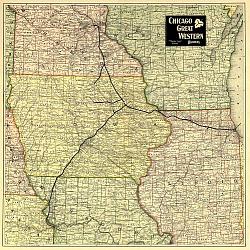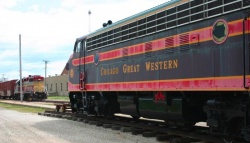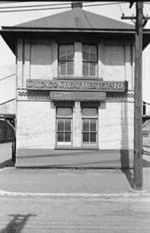Encyclopedia Dubuque
"Encyclopedia Dubuque is the online authority for all things Dubuque, written by the people who know the city best.”
Marshall Cohen—researcher and producer, CNN
Affiliated with the Local History Network of the State Historical Society of Iowa, and the Iowa Museum Association.
CHICAGO AND GREAT WESTERN RAILWAY
CHICAGO AND GREAT WESTERN RAILWAY. The Chicago Great Western Railway (CGW) linked Chicago, Minneapolis, Omaha, and Kansas City. It was founded by Alpheus Beede Stickney in 1885 as the Minnesota and Northwestern Railroad, a regional line between St. Paul and the Iowa state line. (1)
Through mergers and new construction, the railroad, named Chicago Great Western after 1892, soon became a multi-state carrier. It competed against several other more well-established railroads in the same territory and used innovation and efficiency to survive. Nicknamed the "Corn Belt Route" because of its operating area in the midwestern United States, the railroad was sometimes called the "Lucky Strike Road," because of the similarity in design between the herald of the CGW and the logo used for Lucky Strike cigarettes.
In 1854, the Legislature of the Territory of Minnesota chartered the Minnesota and Northwestern Railroad (M&NW) to be built between Lake Superior, Minneapolis and Dubuque, Iowa. Construction did not proceed, however, until it was purchased by Stickney and another investor in 1883. By 1886 a line between St. Paul, Minnesota and Dubuque had been built.
The depot in Dubuque was located at 399 E. 8th St. The line ran north past the FLEXSTEEL INDUSTRIES, INC. plant and turned west before reaching Sageville. (1) The track continued through Durango and Graf, north of Epworth and Farley, and then along the ILLINOIS CENTRAL RAILROAD tracks into Dyersville. The former right-of-way became HERITAGE TRAIL. (2)
By 1888, not only had the railroad changed its name to the Chicago, St. Paul and Kansas City Railroad (CStP&KC), it had finished a continuous line all the way across Illinois to Forest Park, Illinois, except for trackage rights with the Illinois Central across the MISSISSIPPI RIVER. At Forest Park, the railroad made a connection with the ancestor of the Baltimore and Ohio Chicago Terminal for the last nine miles into Chicago's Grand Central Station. The new construction included Illinois' longest railway bore, the Winston Tunnel, south of Galena.
Through merger and construction, the CStP&KC added lines between Oelwein, Iowa, on the Chicago-to-St. Paul mainline, and Kansas City, Missouri, by 1891, and between Oelwein and Omaha, Nebraska by 1903. Oelwein became the hub of the railroad, and its main locomotive repair shops were soon located there.
The Great Western expanded its feeder branch lines in Iowa, Minnesota and Illinois, but plans to continue expanding the railroad north to Duluth, Minnesota, west to Sioux City, Iowa or Denver, Colorado, or south into Mexico, were not carried out.
The railroad survived the Panic of 1893 to become the Chicago Great Western. It soon developed a reputation for being an innovative and progressive competitor for traffic. The Panic of 1907, however, forced it into bankruptcy; the road was purchased by investors connected to J. P. Morgan. Samuel Morse Felton, Jr. took over from Stickney in 1909. Felton realized that the railroad could not survive without an ambitious effort to innovate and modernize. New rails, new locomotives, and gasoline-powered motorcars replaced steam power on the lightly used passenger trains. The Chicago Great Western Railroad Company was organized August 11, 1909 for the sole purpose of acquiring the properties of the Chicago Great Western Railway Company (The name was later changed back to the Chicago Great Western Railway Company). (3) It served directly the states of Illinois, Iowa, Kansas, Missouri, Minnesota and Nebraska. The Chicago Great Western Railway Company had terminals at Minneapolis, St. Paul, Omaha, Chicago, St. Joseph, Kansas City, and Des Moines. (4)
Felton retired in 1929 because of poor health. In 1935 the railroad declared bankruptcy again. It was reorganized and re-emerged in 1941. The Great Western reduced passenger service, abandoned branch lines and refurbished main lines, and continued the purchase of huge locomotives which pulled enormous trains, sometimes one-hundred cars long or longer. A very important innovation was the "Piggyback Service" which the Great Western introduced in 1936 by moving several hundred truck trailers on specially modified flat cars. The Great Western was also an early advocate of diesel power. It purchased its first diesel-electric locomotive, an 800 horsepower (600 kW) yard switcher from Westinghouse, in 1934. By 1950 the CGW was completely diesel-powered.
A group of businessmen friendly to William N. Deramus, Jr., president of the Kansas City Southern, purchased a controlling share of Great Western stock, and by 1949, appointed Deramus' son, William N. Deramus III, to head the railroad. He continued the modernization and cost-trimming. Under Deramus, passenger service was almost entirely eliminated, and the railroad's offices were consolidated in Oelwein, Iowa. Even longer trains than before became standard operating procedure. This slowed service but increased efficiency.
Upon his resignation, Deramus was replaced by Edward T. Reidy. Innovations continued to keep the company profitable. Second-generation diesel locomotives found their way into the system. The Oelwein Shops stayed busy repairing and maintaining the older units long after many other railroads had replaced theirs with newer models. Passenger service, reduced to two St. Paul to Omaha trains, was gone by 1962. Labor costs were reduced and branch lines abandoned, as the Great Western remained financially strong enough to be considered for merger.
After the failure of a merger with the Soo Line Railroad in 1963, the board of the Great Western grew concerned about its continued existence in a railroad market that was getting smaller. The CGW, therefore, was open to a merger with the Chicago and North Western Railway (CNW), which had first been proposed in 1964. After a 4-year period of opposition by other competing railroads, on July 1, 1968, the Chicago Great Western merged with Chicago and North Western. The CNW maintained the "Oelwein Shops" facilities at Oelwein until 1993. Within two decades of the 1968 merger, most of the CGW right-of-way had been abandoned by the CNW.
After merger and abandonment, some Chicago Great Western trackage and infrastructure remains in service. Long sections of former CGW rights-of-way have been preserved as rail trails, such as the Great Western Trail between Villa Park and Sycamore, Illinois, the Cannon Valley Trail between Red Wing and Cannon Falls, Minnesota, the Sakatah Singing Hills State Trail between Faribault and Mankato, Minnesota, and the HERITAGE TRAIL between Dubuque and Dyersville, Iowa.
---
Source:
1. Meyer, Jeffrey J. "Clear the Track," Julien's Journal, March 2010, p. 36
2. Ibid.
3. "A Brief History of the Chicago Great Western Railroad Company," Train Web, Online: http://trainweb.org/ucgw/hsfcgw10.htm#cgwroad
4. Ibid.





